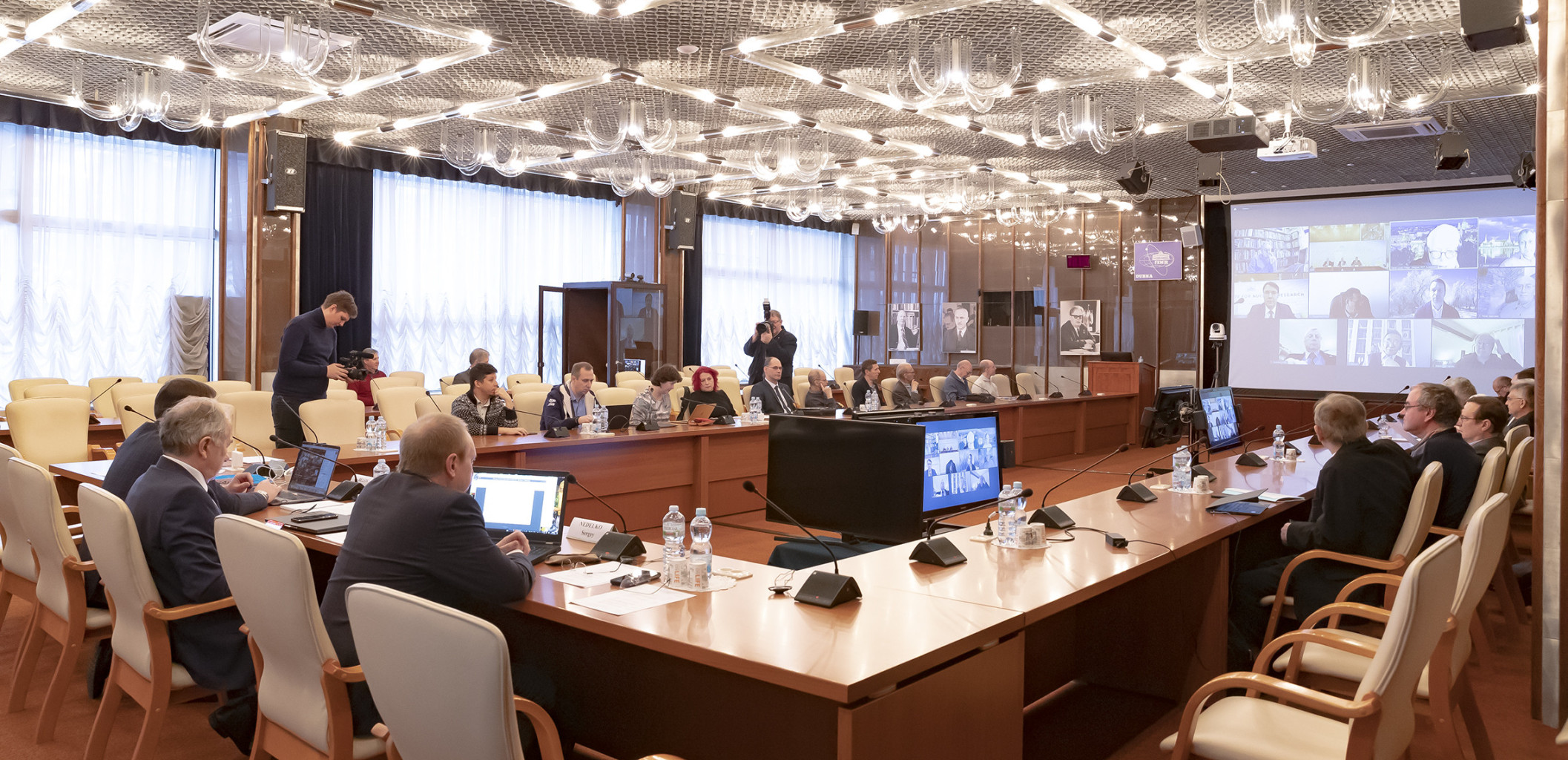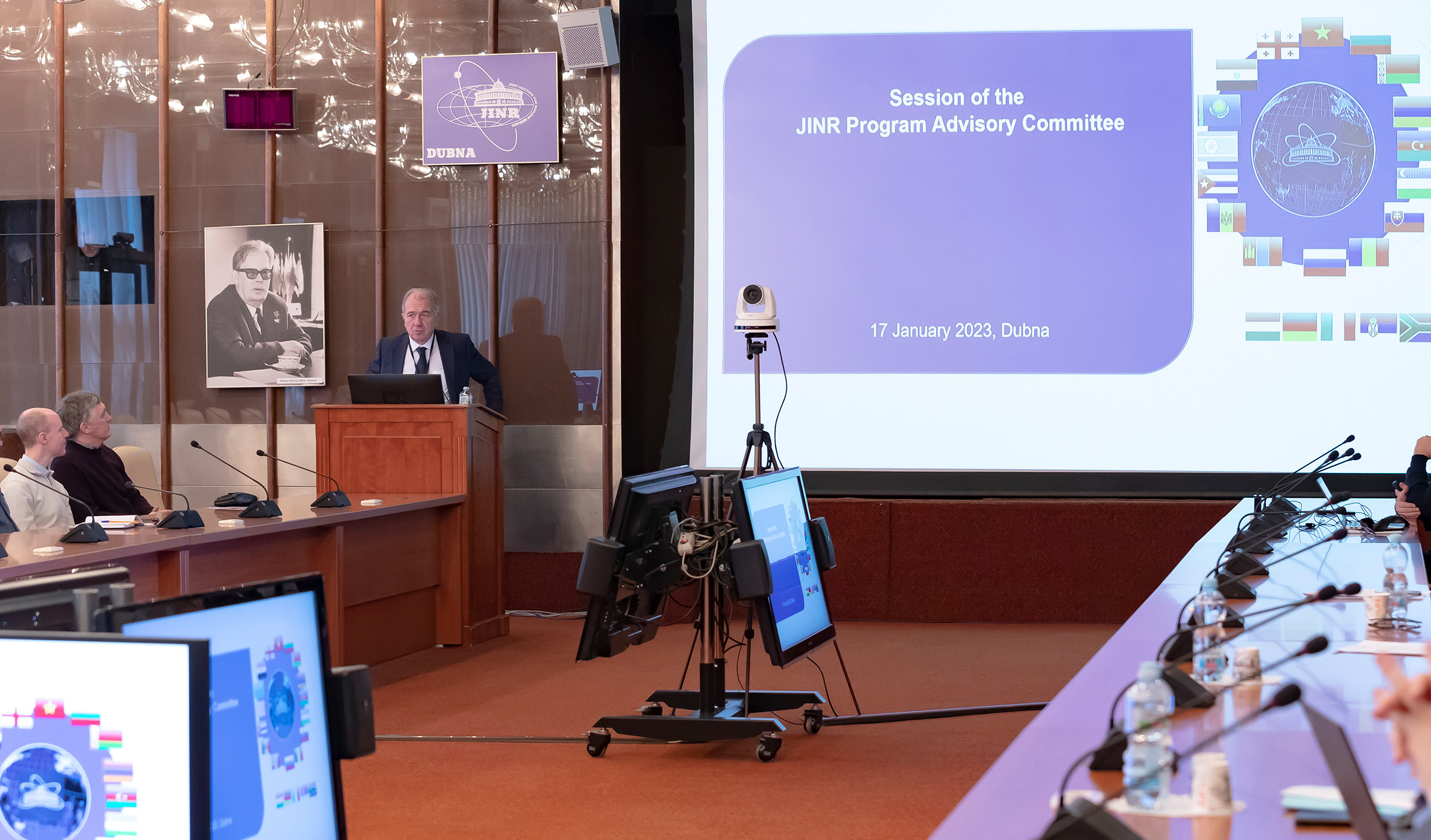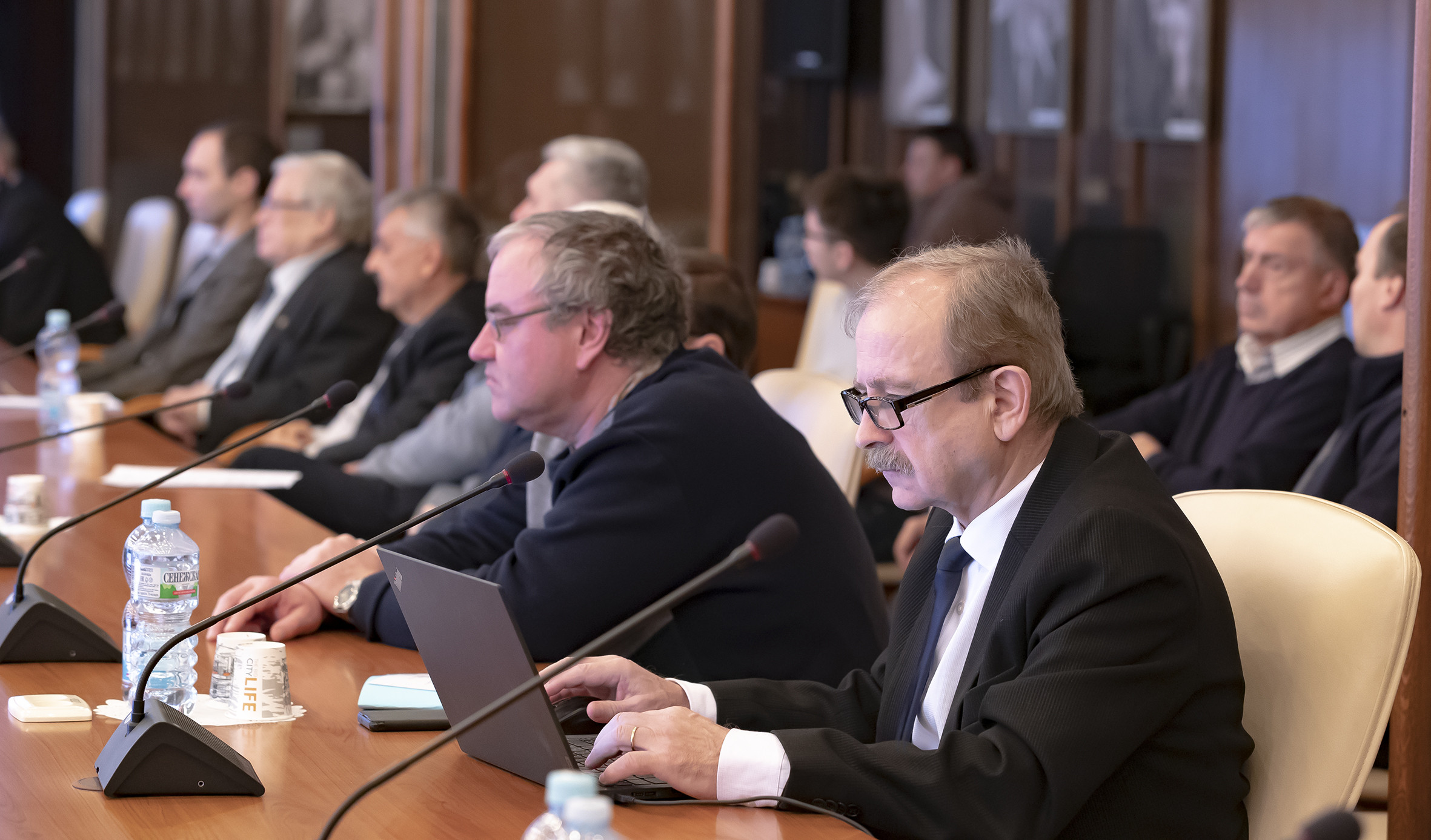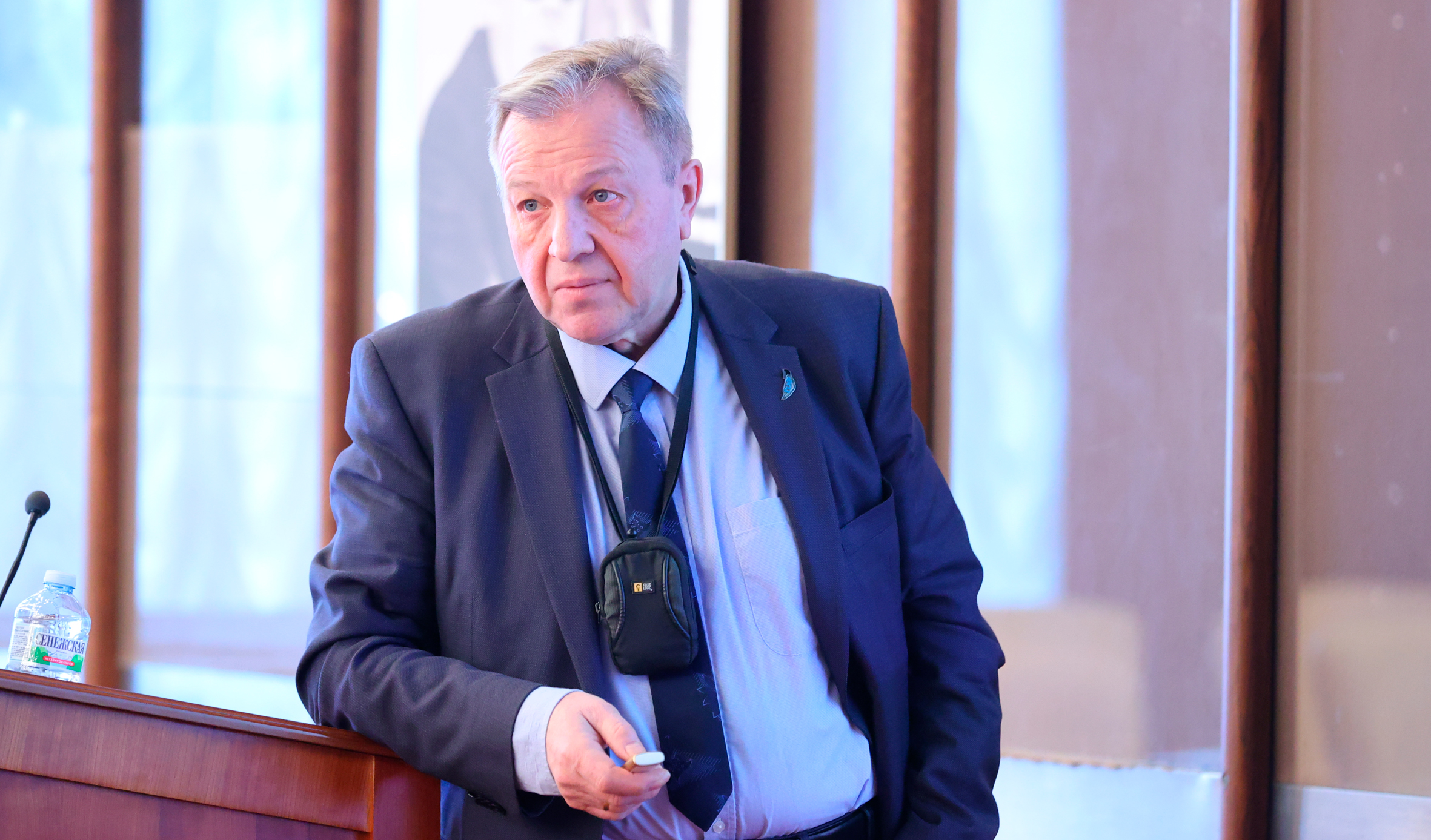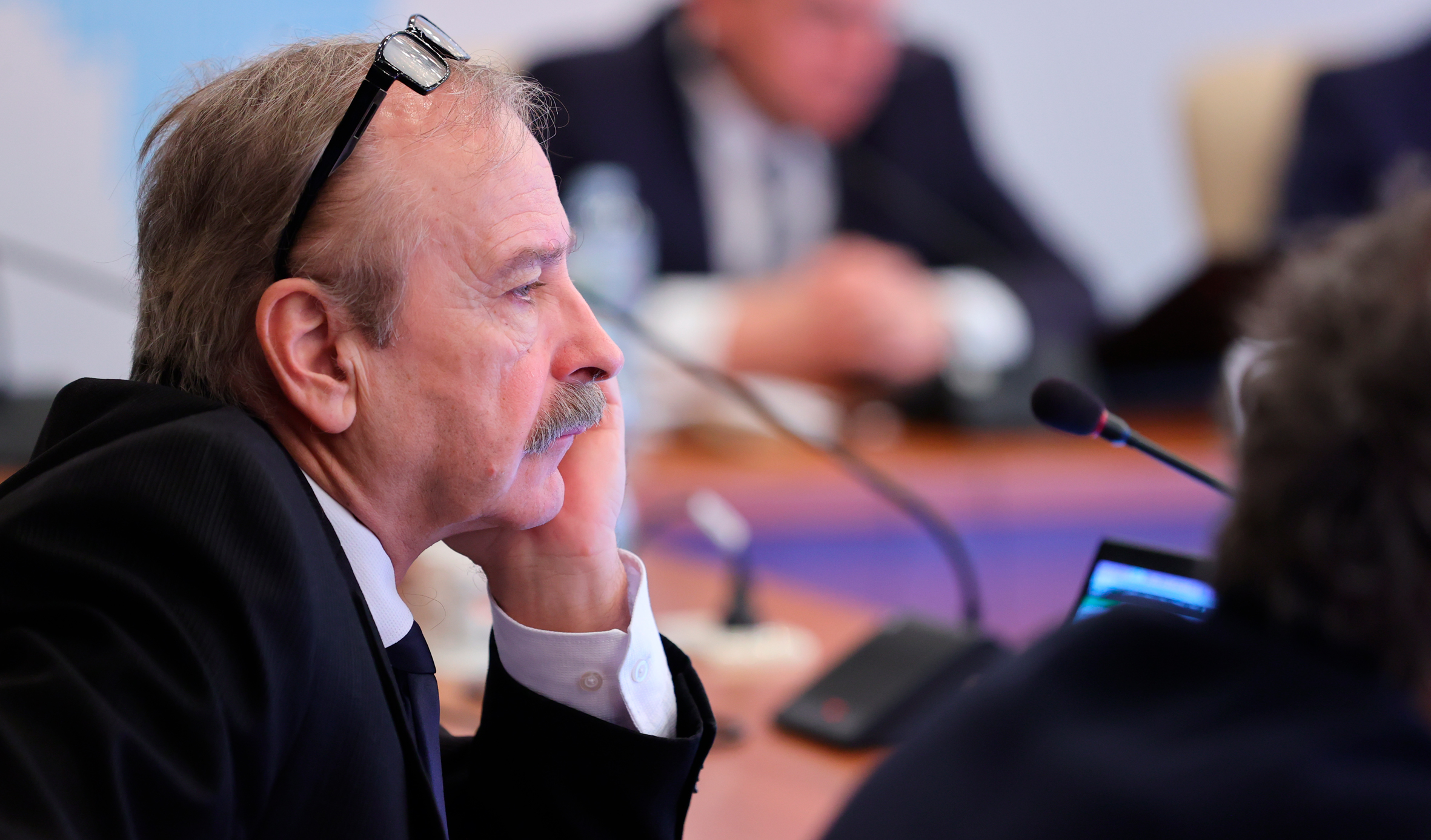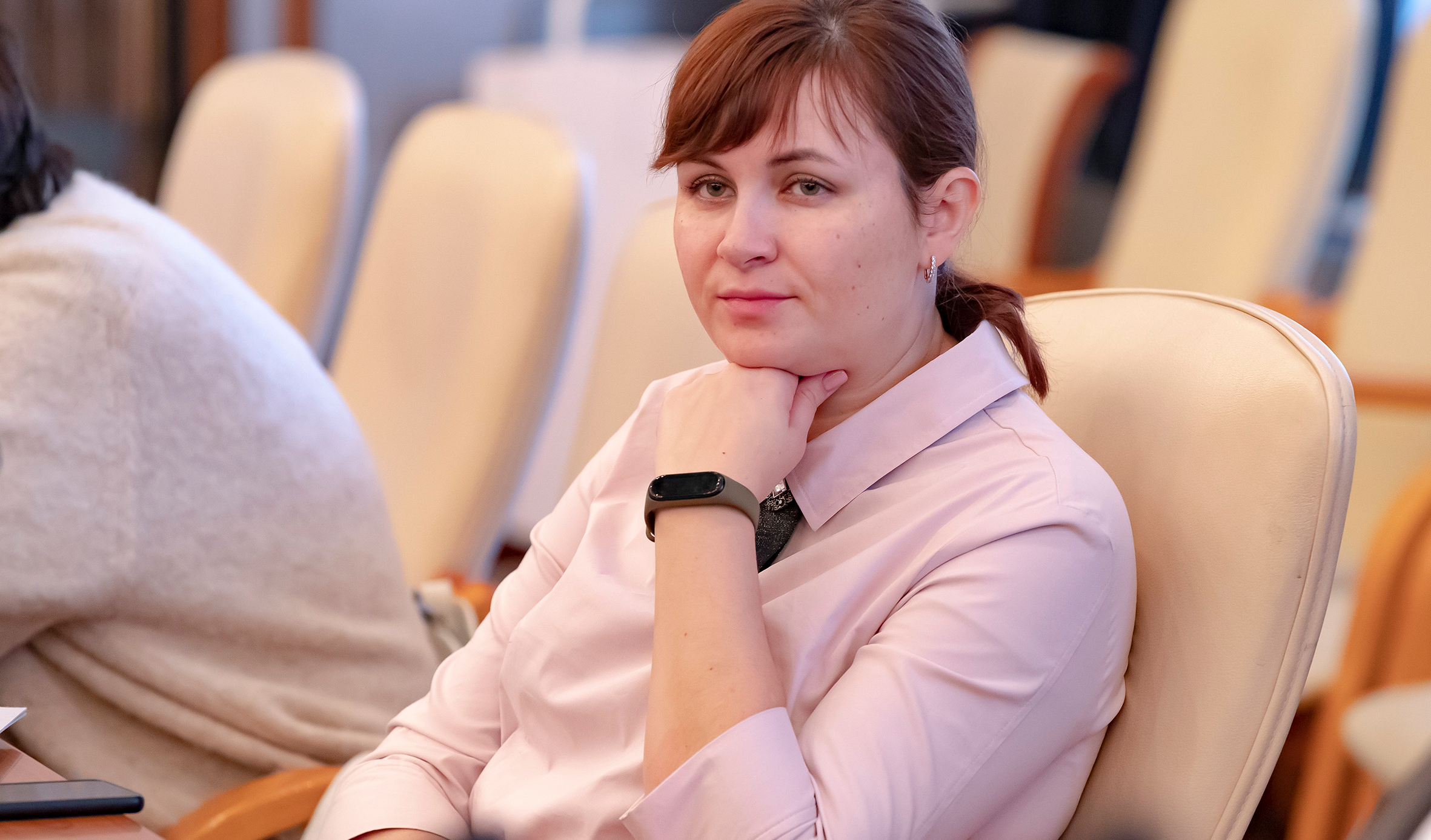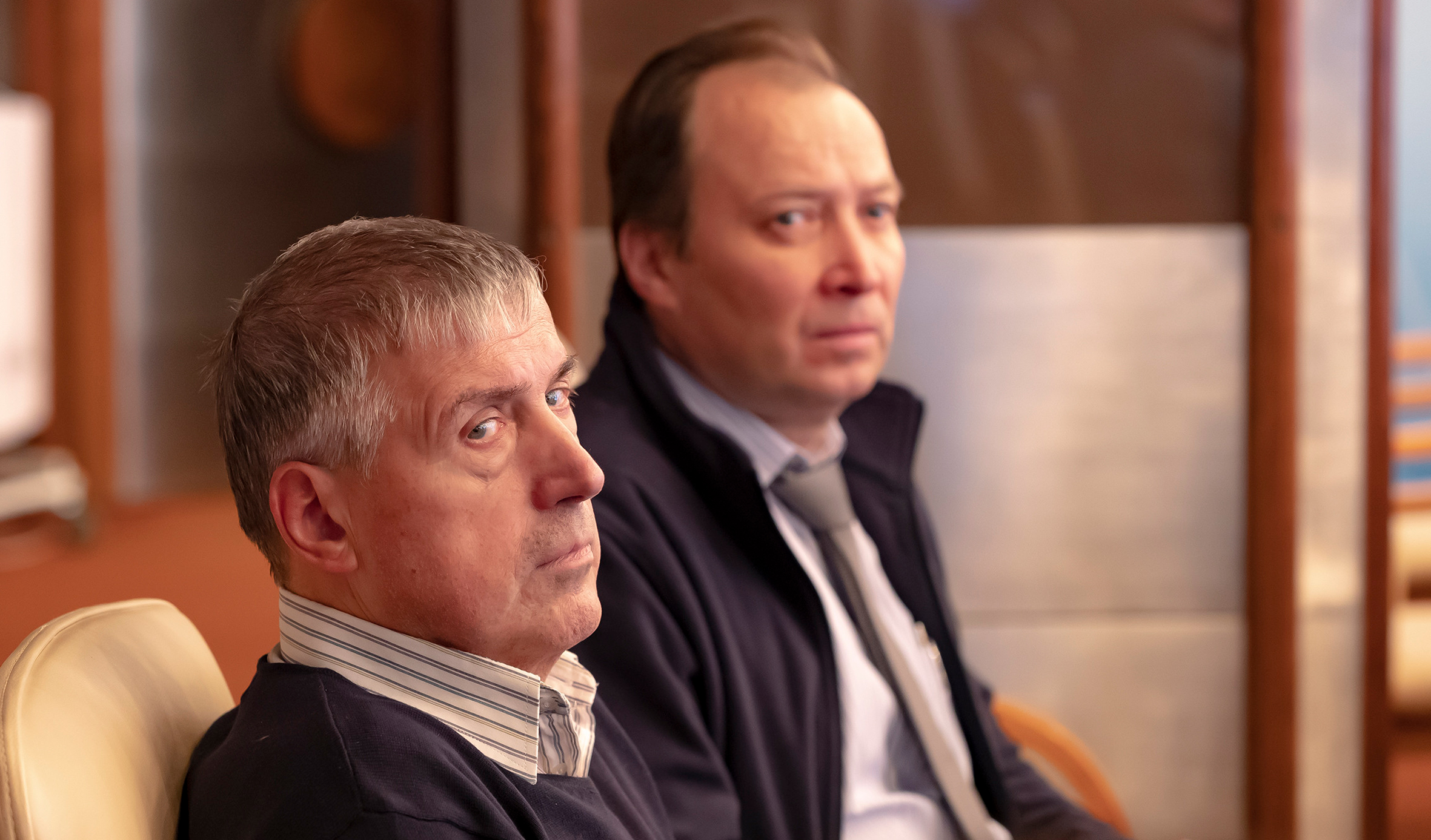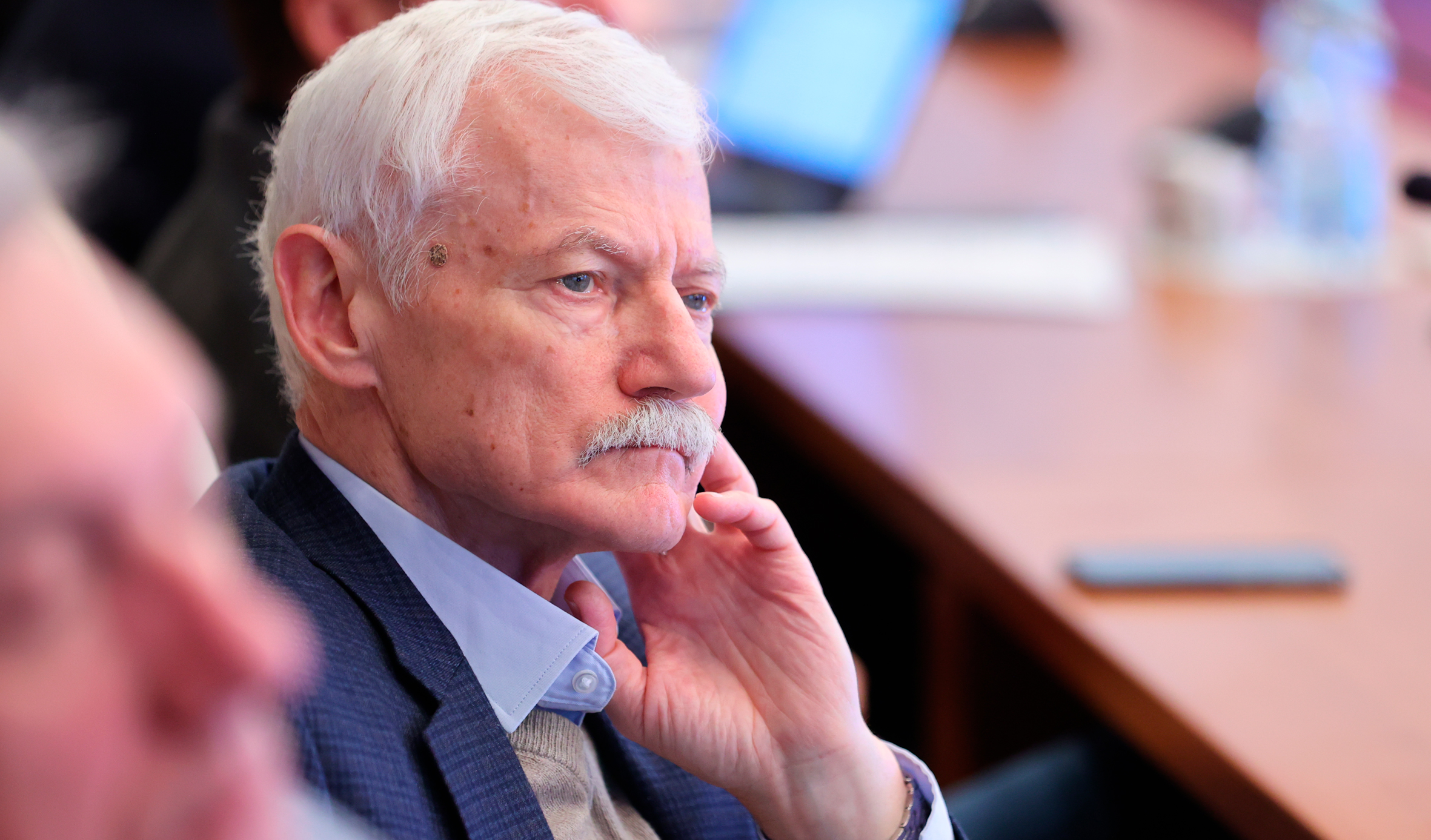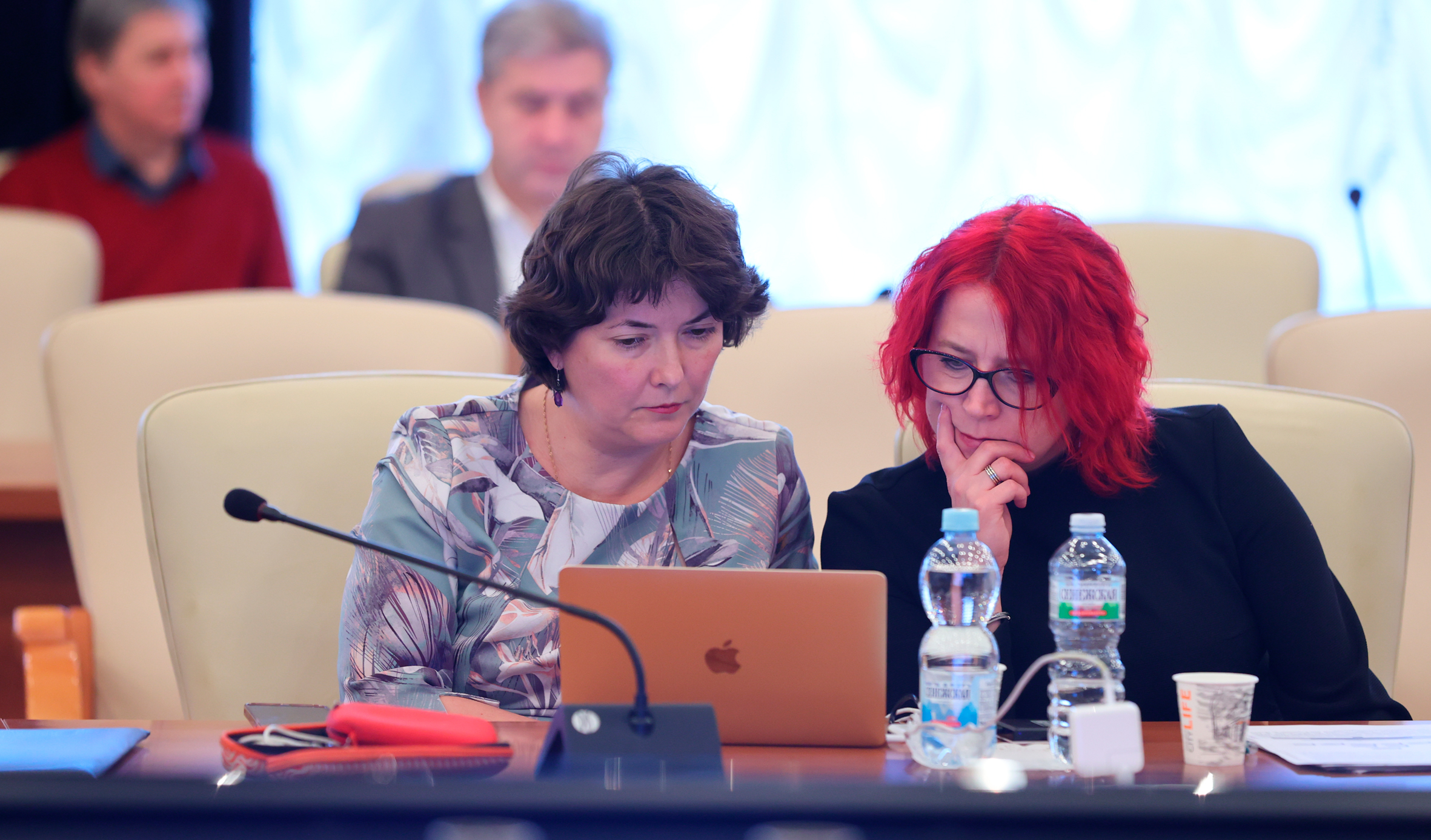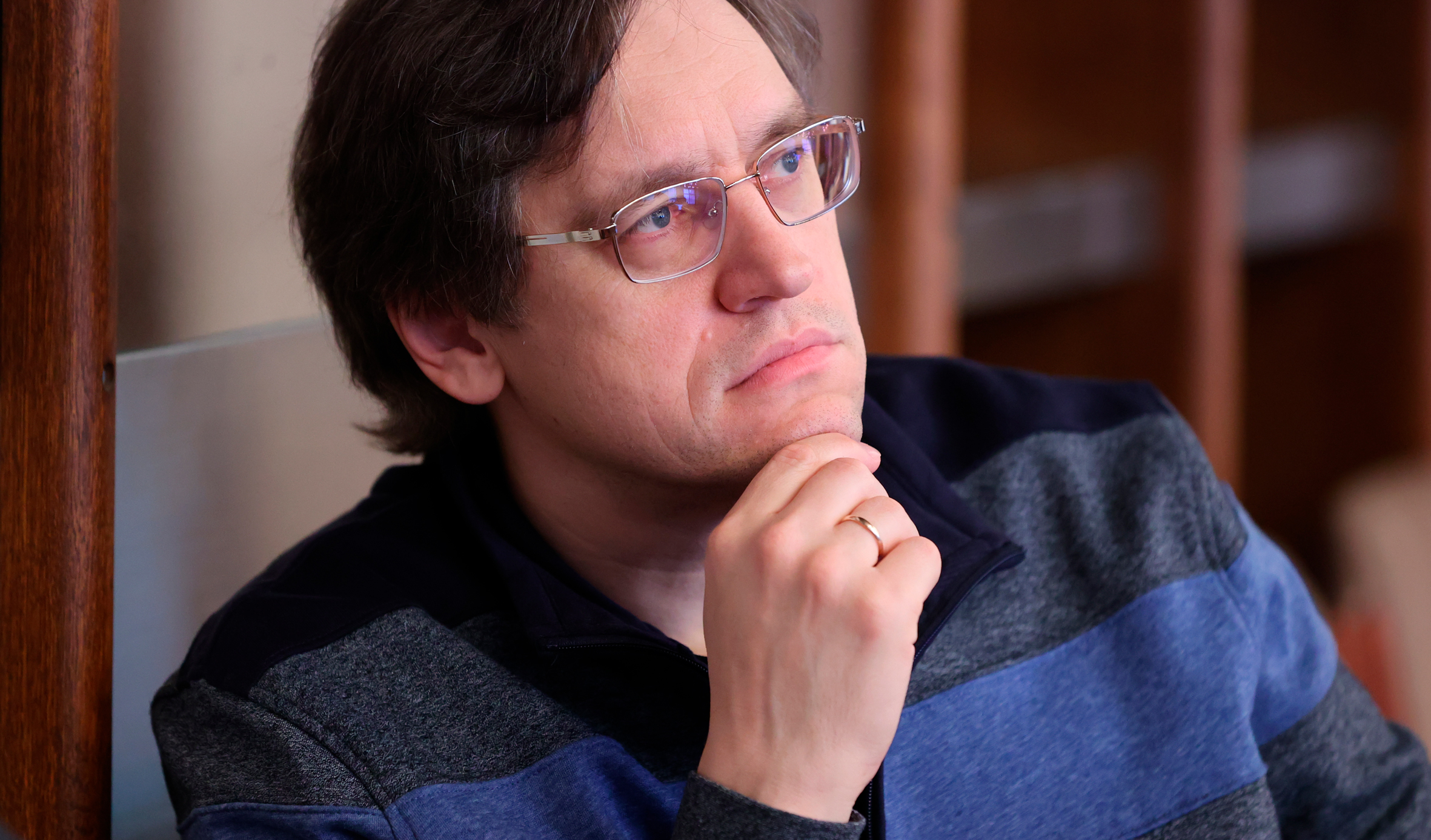Discussing reactor and new projects at meeting of PAC for Condensed Matter Physics
News, 17 January 2023
Today, the 56th Meeting of the Programme Advisory Committee for Condensed Matter Physics has started in the International Conference Centre in a mixed format. Participants of the two-day event are discussing the status of the IBR-2 Reactor and considering new topics and projects to be included in the Topical Plan for JINR Research and International Cooperation in 2024.
The current event opens a series of meetings of the Programme Advisory Committees after a one-year break, during which specialists were intensively working on the new Seven-Year Plan for the Development of JINR 2024 – 2030 and the improvement of the JINR Topical Plan concept.
Addressing the participants of the PAC CMP meeting with a welcoming speech, JINR Director Grigory Trubnikov highlighted that the programme of the PAC CMP meeting will focus on the presentation of the status and further plans of the flagship projects of the Institute. JINR Director told participants of the event about the state of the art of the Institute. “The Institute is in excellent shape. 2022 was full of good scientific results in all areas of research. JINR continues actively developing cooperation despite external factors,” Grigory Trubnikov emphasised. Noting that it was possible to strengthen ties with India, Latin American countries, China, Japan, JINR Director expressed hope that the ambitious international scientific programme of the Institute will be implemented in 2023 through joint efforts.
Chairman of the Committee Dénes Lajos Nagy opened the working programme of the meeting. He presented its participants with information on the implementation of the recommendations of the previous PAC CMP meeting. Vice Director Latchesar Kostov presented information on the Resolution of the 132nd session of the JINR Scientific Council (September 2022) and the decisions of the Committee of Plenipotentiaries of the Governments of the JINR Member States (November 2022).
Director of the Frank Laboratory of Neutron Physics JINR Valery Shvetsov spoke about the status of the IBR-2 Reactor, presenting the updated dates for the facility’s resumption of operation. New heat exchangers have been created and are currently being tested. In March-April, they will be delivered to the Laboratory. An FLNP team is going to install them in the summer of 2023. In April-May, it is expected that the Laboratory will receive an operating licence of the Federal Service for Environmental, Technological, and Nuclear Oversight (Rostekhnadzor). Afterwards, the reactor will be launched again in October 2023. According to experts, the user programme will be resumed from 2024. One of the FLNP plans for the next seven years will be the manufacturing of a new fuel load for IBR-2 in order to extend the reactor’s service life for the period after 2032. Specialists continue working on the study of the occurrence mechanism of fluctuations in the power pulses of the IBR-2 Reactor in cooperation with the N. A. Dollezhal Scientific Research and Design Institute of Energy Technologies and other organizations of Rosatom. Chief Engineer of the IBR-2 Facility Andrey Dolgikh presented to participants of the event the tasks and prospects for the reactor operation. During the meeting, the PAC CMP members are discussing the status of the IBR-2 Reactor and the scientific programme of the spectrometer complex.
The members of the Committee considered reports on the topics to be included in the Topical Plan for JINR Research and International Cooperation in 2024. They also discussed approaches to reviewing projects submitted for consideration at PAC and listened to information about the status and prospects for the scientific programmes of MLIT and DLNP.
On the second day of the Committee’s work, Elena Zavyalova will present to the meeting participants a scientific report “Diagnostics of socially significant diseases using affine track membranes modified with DNA aptamers”. Within the programme of the event, there will be a meeting of the PAC CMP members with the JINR Directorate and online poster presentations.
On 17 – 18 January, the 56th meeting of the Programme Advisory Comittee for Condensed Matter Physics of JINR was held in a hybrid format. Most of its programme was dedicated to reports on the present and future of the IBR-2 Reactor, part of its experimental environment and the new neutron source. Director of FLNP Valery Shvetsov reported on the status of the IBR-2 Reactor within the framework of the new Seven-Year Plan for Development of JINR and Andrey Dolgikh presented the tasks and prospects for the operation of the reactor. Three reports covered FLNP topics proposed to be included in the JINR Topical Plan for 2024. Maxim Bulavin reported on the status of work and plans for the development of a new neutron source at FLNP JINR until 2030. The Committee experts learnt about the status and prospects of the scientific programmes of MLIT and DLNP, the report on “Investigation of the biological impact of ionizing radiation with different physical characteristics” was presented by Director of LRB Aleksandr Bugay.
Welcoming the members of the Programme Advisory Committee, JINR Director Grigory Trubnikov expressed his hope for the meeting to be fruitful. As he noted, despite the turbulence in politics has been impossible to predict, the Institute has retained its international status, achieves outstanding results, develops its projects and basic facilities. The cooperation with the scientific centres of India, Mexico, Argentina, Brazil, Egypt, China and Japan expands. Moreover, JINR currently cooperates with European countries, CERN, IAEA, BMBF, as well as in the framework of the FAIR project.
The Institute’s media has received the first comment from FLNP Director Valery Shvetsov,
“Chairman of the PAC made my and Andrey Dolgikh’s reports to be the first ones. I, with less detail and he, with more details, spoke about our activities aimed at putting the reactor into operation as quickly as possible. There are stages along the way that cannot be carried out faster. The precise analysis of the documentation that we submit to Rostekhnadzor is implemented for six months and this period cannot be reduced in any way. As I have said just now in the report and at the PAC meeting a year ago, we were going to change the heat exchangers in April last year, but circumstances such as the pandemic, special military operation became reason for them not to be manufactured in spring. The next deadline was October 2022, they again missed it, but after September, we didn’t care, for in September, the Rostekhnadzor license expired, according to which we have the right to carry out repair work on the reactor.
Today, the heat exchangers are manufactured, the welds are currently checked and the documents are under examination. We will get the heat exchangers in spring, if by this moment we are sure that we will receive a license, then we will dismantle the roof of the building where they are located, we will block the bypass road for assembly work, the arrival will remain only around the neutron guide.
With regard to extending the service life of the reactor, we are currently at the beginning of experimental research. We will send the burnt-out cassettes to the Institute of Reactor Materials at Zarechny to study the resistance, the condition of the components and we will carry out experiments with the Snezhinsk Physics and Technology Institute based on the ideas of Evgeny Shabalin. They will need to validate his calculations and simulations of the bendings that occur in fuel elements. The cassette is a more complex structure than a separate fuel element and it is impossible to calculate the relative displacement of the fuel rods when the entire cassette is bent. We can implement research with a fresh cassette.”
“At the same time, are you optimistic that the reactor will operate after 2040?”
“Yes, if we make a new fuel loading, then after 2040 it will operate. We have enough stock.”
Chief Engineer of IBR-2 Andrey Dolgikh makes further discussion,
“We took advantage of this shutdown in the operation of the reactor to upgrade some equipment, to carry out repairs somewhere, to prepare the required documents, to revise the instructions, especially since there are constant inspections by Rostekhnadzor, they give us instructions that must be followed. In a few years, we will need to refuel the core with fresh fuel that will require a number of complex tasks. And only after we obtain and load the fuel into the core, the reactor will be able to go on operating, provided that its other systems are still operational. The service life of even those systems that were replaced during the modernisation period 12-13 years ago, will come to an end in 10 years and it will be necessary to think whether to extend their life or change them and these are quite costly things. A correlation with the new source must also be made, it is desirable that there is no break, or at least a long break between the end of the operation of the old IBR-2 source and the start of operation of the new one, so that physicists can carry out further research with neutrons.
Denis Kozlenko introduced the projects on “Investigations of fundamental materials and nanosystems using neutron scattering” to the PAC members within the framework of the new Seven-Year Plan,
“Materials science, both from applied and fundamental points of view, plays an essential role in the development of many aspects of our life. In fact, this is the basis for the development of new technologies and the search for new interesting materials with different functional properties that can be used to construct various devices and products. Neutron scattering methods are of great significance for they allow one to efficiently study systems containing light atoms, such as oxygen, lithium and hydrogen. These systems are for designing current devices – lithium batteries, various oxide elements, magnetic materials. Neutrons have a high penetrating power that allows us to study three-dimensional systems and products, as well as to efficiently use them in the investigations of the structural, magnetic properties and dynamics of various functional materials.
Our investigations will be scheduled in accordance with what we have already implemented on the basis of the IBR-2 spectrometers complex. For instance, we will study alloys with the effect of the so-called giant magnetostriction based on iron-gallium. These are materials in which an extension of the substance occurs in the applied magnetic fields. We investigate various microstructural bases for the manifestation of this effect. Materials for current sources – batteries, accumulators are also currently investigated. Recently, new oxide materials have been studied that have increased capacitive properties, such as, based on sodium oxide, manganese, and oxygen. They allow us to charge with increased capacity and at high velocity.
Traditionally, a wide range of nanosystems has been studied. For instance, the structural organization of systems of so-called superwetting agents. These are substances of the surfactant type (surface-active substances), the simplest surfactants are washing powders. As a rule, they are not very convenient to use on hydrophobic surfaces that repel liquids. It is important that the surfactant flows well and interacts well and when the surface is hydrophobic, conventional surfactants do not operate very well. Special surfactants, superwetting agents are produced. We have investigated one such sample, the trisiloxane system, to understand how the superwetting effect is achieved, how it differs from a typical surfactant that does not have a superwetting effect on a hydrophobic surface.
Many other systems have also been studied, such as, the organization of polymer gels to which various substances have been added and rather interesting effects concerning the structural organization have been observed. Biological systems have also been studied, for instance, an interesting investigation on the protein crystallisation in micellar systems has been carried out. Membrane proteins play a huge role both for biology and from the point of view of the processes occurring in living organisms and what is very important, the production of many drugs is aimed at influencing membrane proteins. And in order to study these proteins, one needs to understand how to crystallise them, for it is in the form of a crystal that it is best to study their structural properties. It was not completely clear what happened during the crystallisation of membrane proteins. In our laboratory, together with the Moscow Institute of Physics and Technology, we have developed a technique for crystallisation of micellar proteins, adapted to X-ray investigations. This was a complementary, neutron-X-ray work that allowed us to characterise in detail all the stages of the processes occurring during the crystallisation of proteins from a micellar system. It has turned out that this sequence is much more complicated than it has been expected. Our investigation will improve the scientific basis for obtaining membrane proteins for further research.
As always, we have worked in various applied research areas. These are the investigations that have been carried out on various structural materials used in industry, alloys, defects occurring in them and internal stresses. Objects of cultural and natural heritage have also been investigated. For instance, the Kunya-Urgench meteorite that fell in Turkmenistan in June 1998, has been studied. Despite the fact that it is either one of the five or ten of the largest meteorites known to mankind, its phase composition and internal structure have not yet been studied in detail. We have succeeded to get a fragment of this meteorite from the Institute of Astronomy in Moscow. We have characterised its phase composition using neutron tomography, radiography, as well as diffraction, Raman spectroscopy and have obtained a detailed picture of its phase composition and the distribution of various inclusions in it.”
The results of the meeting were summed up by Chairman of the PAC Professor Denes Lajos Nagy.
“The major topic of the meeting was the state of IBR-2 and the further research on its spectrometers. Did the PAC experts support all the proposed projects?”
“The report by FLNP Director Valery Shvetsov, followed by a report by Doctor of Sciences Andrey Dolgikh, as well as their discussion, were indeed one of the most essential events of our meeting. However, there were other issues of utmost importance on the agenda of the PAC, too. It included, for instance, information on the resolution of the 132nd session of the JINR Scientific Council (September 2022) and on the decisions of the Committee of Plenipotentiaries of the Governments of the JINR Member States (November 2022) provided by JINR Vice-Director Latchesar Kostov. Further, a traditionally essential point was the meeting of the PAC with the members of the JINR Directorate, first of all with JINR Director Grigory Trubnikov that delivered his report for more than half an hour, as well as very frankly and constructively answered the questions of the PAC members, some of which were quite sensitive ones.
Going back to your original question, the PAC is satisfied with the progress made in replacing the air heat exchangers in the second cooling circuit of the IBR-2 Reactor and obtaining an operating license. The PAC approved FLNP’s plans for the next seven years that include the manufacture of a new fuel load for IBR-2 to provide the required conditions for extending the reactor’s service life beyond 2032. The PAC also highly appreciated the FLNP’s further work on studying the mechanism of the occurrence of fluctuations in the power pulses of the IBR-2 Reactor, together with NIKIET and other organizations of the State Corporation Rosatom. The Committee recommended FLNP to make a decision on the choice of a manufacturer of components for a new fuel load for IBR-2. The PAC highlighted the significance of resuming the regular operation of IBR-2 in 2023 and also of the user programme in early 2024.”
“They make further discussions on the development of a new neutron source. Also, three topics of FLNP were proposed to be included in the JINR Topical Plan. Did Committee members appreciate the relevance of these topics?”
“In fact, four topics were proposed by FLNP, one of them, namely the one presented by Dr. Grigory Arzumanyan, uses photons, not neutrons. The report by Dr. Maxim Bulavin was dedicated to the development of a new JINR neutron source. However, the PAC had nothing to estimate this time, we rather made a kind of landscape tour of the topics that should be included in the JINR Topical Plan for JINR Research and International Cooperation for 2024. Indeed, estimation is a different matter and should be preceded by peer review, estimation of peer review reports, others. This will be the task for the PAC at the upcoming meeting in June this year. It is expected that the estimation will be carried out after the appropriate preparatory measures are taken via the electronic communication of the Committee members in spring.”
“How did the PAC estimate the status and prospects for the scientific programmes of MLIT and DLNP? FLNR and LRB also presented their topics.”
“My previous answer applies, of course, to the topics presented by MLIT, DLNP, FLNR, and LRB.”
“Traditionally, the poster meeting was held online. Is it harder to estimate the papers of young scientists online than live?”
“No, just the opposite. Young scientists prepared short electronic presentations of up to six slides. Zoom breakout room option allowed us to “walk” around the speakers and discuss the details of the presentations with them and other attendees as if we were in person at a poster meeting. After the closing of the breakout rooms, the votes were sent in an electronic way to the Scientific Secretary of the PAC Dr. Oleg Belov that summarised them and announced the voting results. I would like to thank him, as well as Dr. Timur Tropin for helping everyone that needed help during the virtual poster meeting.
It is difficult to predict when we will get together again in Dubna. We all hope that it will happen in June 2023 but in reality this is more than doubtful. However, someday it will happen but I am sure that we should have further online poster meetings. The “good old days” of printed A0 posters, as well as the hustle and bustle for them are thankfully gone forever and I don’t want those times to come back again.”
The winners of the poster meeting were Meir Erdauletov (FLNP) with “Development of lithium-ion batteries with increased specific characteristics”, Inna Kolesnikova (LRB) – “BIOHLIT – information system for radiobiological research”, Nadezhda Belozerova (FLNP) – “Pressure-induced phase transition in nanostructured zinc ferrite”.
